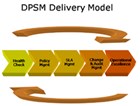Selling Data Protection as a Service

By Nancy Hurley, Bocada President and CEO
Organizations that view data protection as an IT service, offered to either internal or external customers, require a standard set of operational processes in order ensure successful service delivery and drive down operational costs. The Data Protection Service Management Model (DPSM) is an ITSM-like actionable methodology targeted at enhancing the delivery of data protection services. The model outlines a multi-phased approach to assess the overall data protection delivery infrastructure effectiveness, improve the ability to deliver quality data protection and recovery services, publish the results to customers and continuously advance the effectiveness of data protection operations while lowering costs.
The DPSM model leverages the collective experience of leading enterprise customers and service providers, and draws upon their best practices using backup reporting solutions. Customers include enterprise organizations serving internal business units, as well as MSPs and SaaS providers delivering backup and data protection services to external customers. This model channels organizations through progressive stages of delivery management and helps to incrementally realize higher degrees of customer satisfaction while driving out operational costs. The five phases of the model include:
Phase 1 — Initial Assessment The initial Health Check/Assessment phase helps reveal the true effectiveness of an organization's data protection environment and enables effective Problem Management by pinpointing, diagnosing and helping eliminate trouble spots and identifying opportunities for improvement.
Phase 2 — Policy Development In the Policy Management Phase, users can evaluate existing policies to ensure they support the goals of the business. This phase exposes areas where Policies and processes can be modified to better ensure success, recoverability and IT business alignment.
Phase 3 — Services Delivery Management Being able to deliver on SLAs is critical for operational excellence and customer satisfaction. In this phase users are encouraged to create a service catalog, accurately set services management SLAs and effectively measure adherence and success rates. Publishing reports promotes better communication results with customers thereby increasing satisfaction rates.
Phase 4 — Change and Audit Management DPSM is a continuous process, and therefore tracking change in the data protection environment is critical for exposing areas of risk, identifying unprotected assets, planning capacity requirements and confidently passing compliance audits.
Phase 5 — Operational Excellence Standardizing on the processes developed in previous phases enables streamlined data protection operations, reduced TCO, increased IT business contribution and customer retention. While each phase in the model should be revisited regularly in order to continuously improve operations and lower costs, all organizations should start with the initial assessment health check and then move to the next phases as appropriate. As the IT organization moves from one phase to the next, it realizes a wide range of benefits such as a shift from reactive problem solving to proactive management, gaining better understanding of the quality of the services delivered and continuously improving upon service delivery and customer satisfaction.
Driving DPSM through the Channel
For businesses that rely on effectively delivering data protection services to their customers, the DPSM delivery model is a blueprint that outlines the steps and best practices for getting control of customers' data protection environments in order to ensure recoverability, more effectively deliver against SLAs, reduce risk, better communicate with customers and lower overall CAPEX/OPEX costs.
The DPSM strategy is perfectly suited for channel partners, particularly those who provide professional services and consulting. Filling an important gap in data protection management, the ideal DPSM solution is easy to use and provides:
- A clear, simple workflow process
- SLA impact reports for compliance, trouble shooting and charge backs
- A historical knowledge base that documents incidents and remedial actions
- Service across multiple backup platforms with agent-less technology
DPSM products should be completely focused on enabling successful delivery of data protection services. That means resellers can offer customers not only a superior technical solution, but a business case that makes sense for the bottom line as well.
Organizations today need to transform the way they think about data protection and recognize it is a critical IT service that has business, financial and operational impacts, all of which can be significantly improved if the process is correctly managed and finely tuned. Continual demands of data growth combined with limited budgets and resources provide a compelling need to more effectively protect valuable data assets while maximizing efficiency, minimizing risk and ensuring customer satisfaction. To achieve these goals, Bocada Data Protection Service Management solutions are transforming the way data protection services are delivered, providing greater business and IT alignment while helping lower operational costs and complexities.
